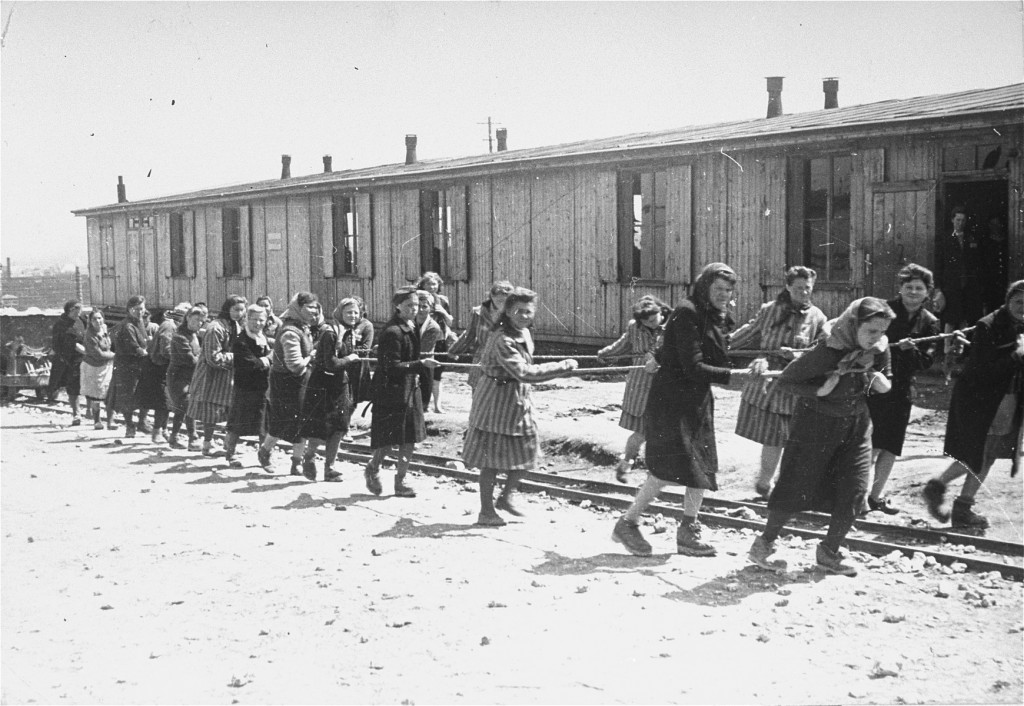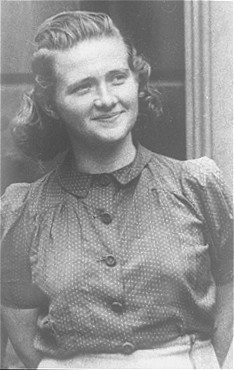
Women during the Holocaust
The Nazi regime targeted all Jews, both men and women, for persecution and eventually death. The regime frequently subjected women, however, both Jewish and non-Jewish, to brutal persecution that was sometimes unique to the gender of the victims. Nazi ideology also targeted Roma (Gypsy) women, Polish women, and women with disabilities living in institutions.
Certain individual camps and certain areas within concentration camps were designated specifically for female prisoners. In May 1939, the SS opened Ravensbrück, the largest Nazi concentration camp established for women. Over 100,000 women had been incarcerated in Ravensbrück by the time Soviet troops liberated the camp in 1945.
In 1942, SS authorities established a compound in Auschwitz-Birkenau (also known as Auschwitz II) to incarcerate female prisoners. Among the first inmates were prisoners whom the SS transferred from Ravensbrück. At Bergen-Belsen, the camp authorities established a women's camp in 1944. The SS transferred thousands of Jewish female prisoners from Ravensbrück and Auschwitz to Bergen-Belsen during the last year of World War II.
The Germans and their collaborators spared neither women nor children—Jewish or non-Jewish—in conducting mass murder operations. Nazi ideology promoted the complete annihilation of all Jews, regardless of age or gender. SS and police officials carried out that policy under the codename “Final Solution.” German SS and police officials shot both women and men in mass shooting operations at hundreds of locations on occupied Soviet territory. During deportation operations, pregnant women and mothers of small children were consistently labeled “incapable of work.” They were sent to killing centers, where camp officials often included them in the first groups to be sent to the gas chambers.
Orthodox Jewish women accompanied by children were especially vulnerable, since people in orthodox Jewish dress were certainly more vulnerable to discovery in hiding or to particularly sadistic behavior in pogrom-like activities. The larger number of children in Orthodox families also made women in those families a special target of Nazi ideology.
Non-Jewish women were vulnerable as well. The Nazis committed mass murder of Romani (Gypsy) women at Auschwitz concentration camp, murdered females with disabilities in the T-4 and other euthanasia operations, and slaughtered women along with men as so-called partisans in many Soviet villages in 1943-1944.

In ghettos and concentration camps, German authorities deployed women in forced labor under conditions that often led to their deaths. German physicians and medical researchers used Jewish and Roma (Gypsy) women as subjects for sterilization experiments and other unethical human experimentation. In both camps and ghettos, women were particularly vulnerable to beatings and rape. Pregnant Jewish women often tried to conceal their pregnancies or were forced to submit to abortions. Females deported from Poland and the Soviet Union for forced labor in the Reich were often beaten or raped, or forced to submit to sexual relations for food or other necessities or basic comforts. Pregnancy sometimes resulted for Polish, Soviet, or Yugoslav forced laborers from sexual relations with German men. If so-called "race experts" determined that the child was not capable of "Germanization," the women were generally forced to have abortions, sent to give birth in makeshift nurseries where conditions would guarantee the death of the infants, or simply shipped to the region they came from without food or medical care. The Germans established brothels in some concentration and labor camps, and the German army ran roughly 500 brothels for soldiers, in which women were forced to work.
Many women incarcerated in the concentration camps created informal “mutual assistance” groups which facilitated survival through sharing information, food, and clothing. Often, the members of such groups came from the same city or province, had had a similar level and style of education, or shared family ties. Other women were able to survive when the SS camp authorities deployed them in clothing repair, cooking, laundry, and housecleaning detachments.
Women in the Resistance
Women played an important role in various resistance activities. This was especially the case for women who were involved in Socialist, Communist, or Zionist youth movements. In Poland, women served as couriers who brought information to the ghettos. Many women escaped to the forests of eastern Poland and the Soviet Union and served in armed partisan units. Women played an important role in the French (and French-Jewish) resistance. Sophie Scholl, a student at the University of Munich and a member of the White Rose resistance group, was arrested and executed in February 1943 for handing out anti-Nazi leaflets.

Some women were leaders or members of ghetto resistance organizations. Among them was Haika Grosman in Bialystok. Others engaged in resistance inside the concentration camps. In Auschwitz I, five Jewish women deployed at the Vistula-Union-Metal Works detachment—Ala Gertner, Regina Safirsztajn (aka Safir), Ester Wajcblum, Roza Robota, and one unidentified woman, possibly Fejga Segal—had supplied the gunpowder that members of the Jewish Sonderkommando (Special Detachment) at Auschwitz-Birkenau used to blow up a gas chamber and kill several SS men during the uprising in October 1944.
Other women were active in the aid and rescue operations of the Jews in German-occupied Europe. Among them were Jewish parachutist Hannah Szenes and Zionist activist Gisi Fleischmann. Szenes parachuted into Hungary in 1944. Fleischmann, the leader of the Working Group (Pracovna Skupina) operating within the framework of the Jewish council in Bratislava, attempted to halt the deportations of Jews from Slovakia.
Critical Thinking Questions
- What additional challenges did women face during the Holocaust at the hands of the perpetrators?
- Investigate women who resisted oppression during the Holocaust in other ways besides armed action.

